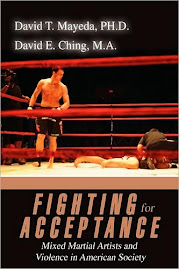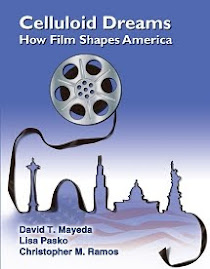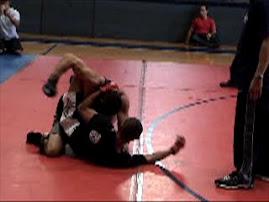 Introduction
IntroductionThis is the third entry in a series examining fighter salaries from the Ultimate Fighting Championship (UFC) and Strikeforce prior to Zuffa’s takeover of the latter promotion. More specifically, this series has illustrated how social stratification – inequality based on wealth, power, and prestige – is rampant among MMA fighters, both men and women. The present article will focus solely on the UFC, looking specifically at how fighter bonuses extend the precarious nature of the athletes’ livelihood.
Methodology
A more detailed description of the methods for this piece can be found here. In short, to collect data for this project, the available information was gathered from MMA websites for each fighter's publicly stated earned income from UFC 100 to UFC 127. Only major fight cards were examined for this project, essentially meaning cards that were held on a pay-per-view basis.
For this sample, a total of 15 fight cards were examined, in which 326 payouts (also known as a fighter's "purse") were made to fighters; fighter salaries for 13 UFC fight cards during this timeframe could not be located.
There are a few important limitations to these methods. First, the public compensation made to fighters within the UFC promotion does not include "backstage/locker room" bonuses that are given to select fighters by management (as noted by commenters in the first article using this data set). Nor does the data set include possible royalties that elite fighters may secure from pay-per-view buys, DVD sales, etc. (which would expand the stratification among fighters since middle and lower-tier fighters would likely not secure such compensation).
Findings
Fighter "excitement incentive bonuses" refer to the "X of the Night" bonuses fighters receive on each UFC fight card. These bonuses are typically awarded to four competitors: for "Fight of the Night" (given to both the winning and losing fighter in the card’s most exciting match), "Submission of the Night" (given to a fighter who wins via the most impressive submission on the card), and "Knockout of the Night" (given to a fighter who wins via the most spectacular knockout on the card).
All of these excitement incentive bonuses come in the form of supplementary income to the fighter’s guaranteed purse (i.e., "show" money), his possible win bonus, and on rare occasion are given to more than one fighter (e.g., sometimes two fighters may be given monetary awards for "Knockout of the Night"). A fighter may also "double up" on these awards; for instance at UFC 106, Josh Koscheck earned a guaranteed $53,000 to show, $53,000 to win, $70,000 for "Submission of the Night," and $70,000 for "Fight of the Night," thereby securing a total purse of $246,000. Among the sample examined in this study, these excitement incentive bonuses ranged in monetary value from $50,000 (given to awardees at UFC 108) to $100,000 (given to awardees at UFC 100).
Again, a total of 326 UFC payouts were examined. Of these 326 payouts, 57 (17.5%) included excitement incentive bonuses, and 269 (82.5%) had none of these bonus types. Contrasts were first made examining the 57 cases, comparing the fighters’ purses including these excitement incentive bonuses versus their purses had they hypothetically not received these bonuses.
Fighter Purses with Excitement Incentive Bonuses (N = 57)
- Mean: $147,477
- Median: $112,000
- Standard deviation: $92,570
- Mean: $74,175
- Median: $36,000
- Standard deviation: $89,028
It is also important to compare the 57 fighters’ purses with the excitement incentive bonuses subtracted versus the 269 fighter purses in which none of these bonuses were given, presented, below:
Fighter Purses with Excitement Incentive Bonuses Subtracted (N = 57)
- Mean: $74,175
- Median: $36,000
- Standard deviation: $89,028
- Mean: $48,750
- Median: $20,000
- Standard deviation: $82,460
This discrepancy reflects two things. First and foremost, those who receive these bonuses are more often winners of matches (a relatively obvious point), who are therefore not only receiving these bonuses, but also in most cases a win bonus (unless they were losers who received a "Fight of the Night" bonus). Additionally, the discrepancy shows that a disproportionate number of fighters receiving these excitement incentive bonuses already have high status and can leverage better contracts should they not secure a supplemental bonus.
In short, the excitement incentive bonuses extend the inequality among fighters. It is far more common to see fighters with high profile names, still in top-tier competitive form who already make substantial incomes earning the excitement incentive bonuses (e.g., Dan Henderson, Anderson Silva, Jon Jones, Chris Leben, Rich Franklin). Conversely, aging fighters and those who are greener, who typically make less money, are less likely to receive these bonuses (e.g., Frank Trigg, David Loiseau, Goran Reljic, Todd Brown).
Of course since only 17% of the payouts in this sample included these particular bonus types, numerous fighters who compete in main events or co-main events do not receive them. However, these fighters are already making healthy incomes (e.g., Vitor Belfort earned $275,000 in a losing effort with no bonuses at UFC 126).
Fighter Bonuses and the Precariat
Given these trends, it is important to consider the necessity of these excitement incentive bonuses, as well as how these particular bonuses increase fighters’ risks. Bear in mind, incentive bonuses already exist – win bonuses. Many argue that without further bonuses that encourage athletes to finish fights in exciting fashion via either submission or knockout, too many fighters will compete simply to win, opting for the safer routes to victory that lack entertainment value.
Such a perspective leans towards treating MMA as spectacle over sport. Many have argued sports in general continuously move in this direction, away from traditional sporting notions (e.g., winning yields the greatest rewards) towards a form of entertainment for fan pleasure. Hence, NFL owners push for a longer regular season that benefits them and the fans, not the athletes.
Furthermore, these particular incentive bonuses disproportionately encourage the lower-tier and poorer fighters to utilize risky fighting styles that resonate with fans who call for increased violence over winning. As early as 2007, Greg Downey stated:
"Promoters encourage fighters to use striking strategies because they are perceived to be more popular with fans. A public relations executive at Zuffa explained to me that, if a fighter put on a ‘good show’ – he was aggressive and exciting to watch – he would be invited back even if he lost" (p. 216).
While bonuses are given for "Submission of the Night," the general tenet expressed by Downey holds true across today’s MMA landscape. Chris Lytle and Leonard Garcia truly exemplify this perspective, both holding long tenures under the Zuffa banner arguably because of their risky approaches to competition. Jon Fitch and Antonio McKee, on the other hand, not only win extensively over very long periods, but win in ways that safeguard their physical and mental health. Thus despite winning extensively over the years, the latter two fighters have not been rewarded in ways that are commensurate with their records.
Up and coming less known fighters and aging out veterans are both groups of fighters looking to build or re-build their names. And they are more commonly in need of hefty monetary bonuses. These are the groups of fighters Guy Standing would refer to as part of the MMA "precariat."
They are part of the vulnerable, expendable working class, or "proletariat," but in this case, their income and work status is constantly precarious. Should they get a contract with the UFC and make it to the scheduled competition, they secure their "show" money, which is typically quite low. Their win bonus is not guaranteed, and would probably double their purse. But gaining an excitement incentive bonus may literally increase their purse six times and improve their chances of future employment. Hence, their financial vulnerability in a precarious market calls for increased risks – risks to winning and to their health.
The more one company commands control of a global industry, the less power workers have to advocate for their rights. Lower-tier fighters’ precarious employment is further threatened by the UFC’s dominance in the global market, where mixed martial artists from different parts of Asia, South America, North America, Europe, and the Pacific vie for a chance to compete and make the highlight reel on the grandest MMA stage.
A hallmark fighter like the current Georges St. Pierre (GSP) can afford financially to not take risks, and may even view risks in competition as jeopardizing his current income and sporting legacy. It is fiscally prudent for a "name" fighter like St. Pierre to fight safe. The complete opposite is true for mixed martial artists who fall in the lowest tiers of a stratified MMA global market.
This means fighters like the current GSP, Randy Couture, and "Rampage" Jackson must remember where they came from, as well as their peers from the 1990s and early 2000s who never made it the elite levels and reaped lucrative financial rewards. Today, GSP makes $400,000 (half to show; half to win) on a typical fight card. In a winning effort at UFC 48 he made $8,000. Will these fighters who currently have power ever make lasting efforts to advocate for their fellow and future workers?
Much more importantly, will administration and ownership consider how incentive bonuses jeopardize their employees? It is hardly outlandish to argue lower-tier fighters are rendered disposable and replaceable across the global market. These particular fighters know they have very limited life chances to impress the brass, and the brass knows the fighters are aware of their own uncertain circumstances.
Rewarding lower-tier fighters would not take much organizational change. On a typical UFC pay-per-view fight card, there are 11 matches with 22 fighters. If excitement incentive bonuses are set at $75,000 a piece, that is $300,000 usually distributed to four fighters. If these excitement incentive bonuses were decreased to $20,000 a piece (still a significant amount of money for lower- and mid-tier fighters), that would leave $220,000 to distribute across the fight night roster. If distributed evenly to just ten of the lowest paid fighters, each would receive an extra $22,000 in guaranteed income.
When I interviewed Guy Mezger years ago, he told me, "…to be honest man, most of the guys, a lot of the guys, they think there’s a huge amount of money in this sport, and there is, for a very small amount of people." Mezger was and still is right – the wealth is there, but not for everyone. If they truly care about all their employees, White, Fertitta and company can and should do a better job of spreading it around.
Up next: how the UFC as a company has skyrocketed in value while fighter salaries lag behind in proportionate growth.
Non-internet Source:

academics blogs









